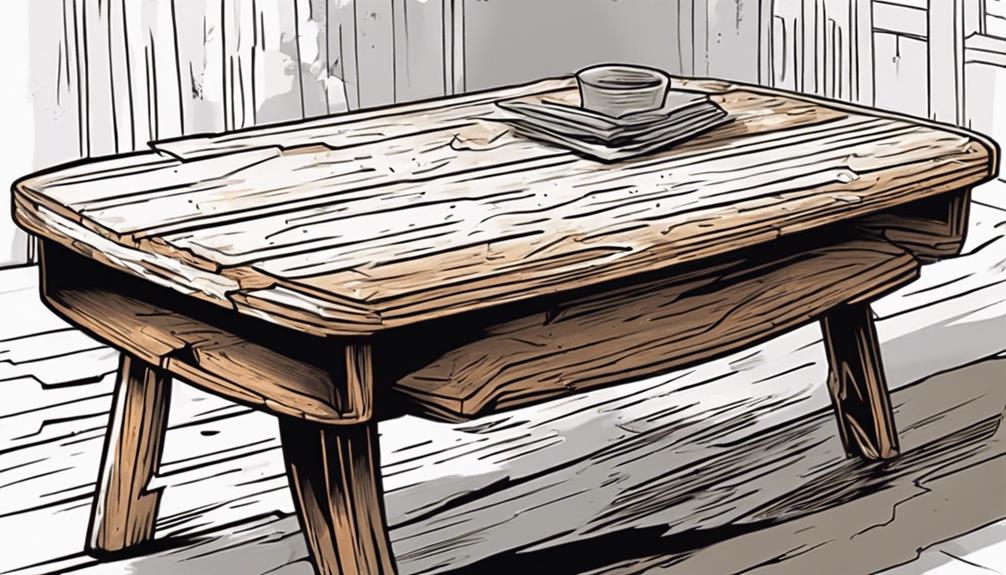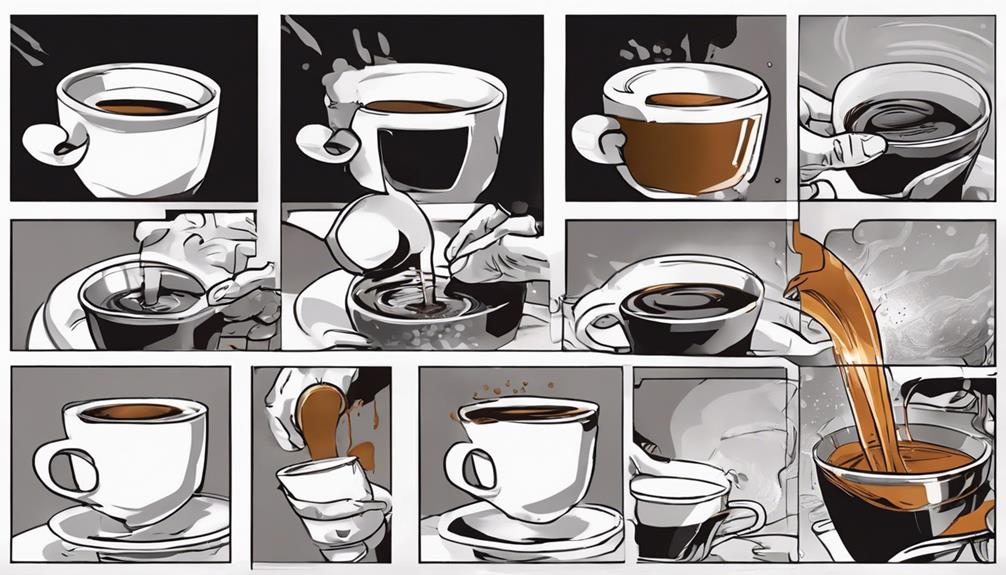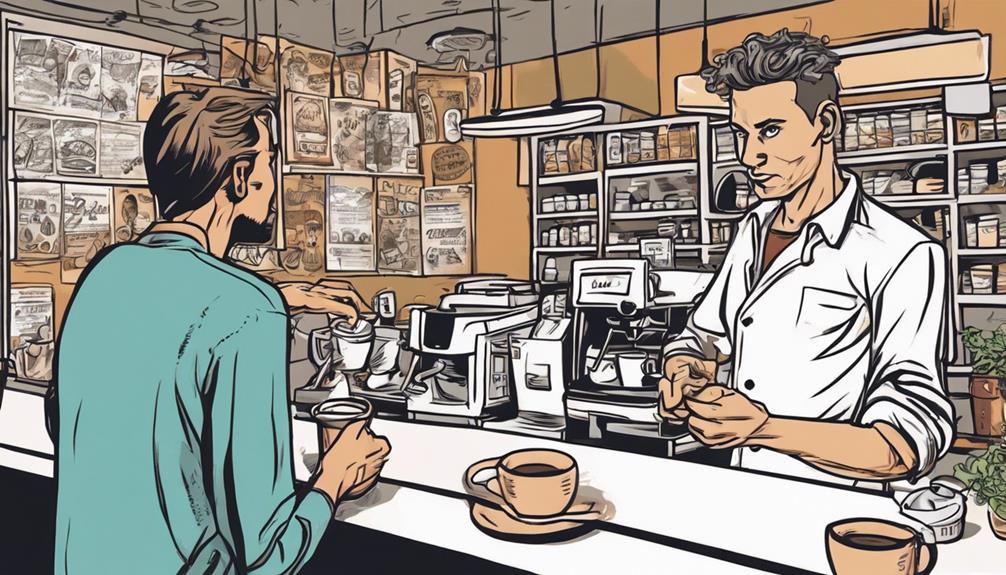Enhance the look of your coffee table with ease by giving it a new finish. Start by gently removing the old finish and treating the wood carefully for a beautiful outcome. Follow a simple step-by-step process to bring back its beauty. Choose a fast restoration method that doesn’t require sanding. Gather basic materials for a quick refresh that will provide elegant results without damage. Learn more techniques and creative ideas to improve the appearance of your coffee table.
Key Takeaways
- Remove old finishes gently with methylated spirits, wire wool, and nylon pads.
- Preserve historical integrity by avoiding harsh chemicals and sanding.
- Enhance wood's color and texture with wax application.
- Achieve a smooth finish by buffing the surface.
- Quick restoration without aggressive sanding in 3 to 5 minutes.
Mahogany Coffee Table Restoration Process
Revitalize your mahogany coffee table with a gentle restoration process that preserves its historical charm and quality.
When restoring a 1720 mahogany coffee table, I'd say delicacy in handling the process is crucial. Begin by removing the shellac finish using methylated spirits, wire wool, and a nylon abrasive pad. This method guarantees a detailed restoration without harming the Cuba mahogany wood's integrity.
To maintain the historical significance of the piece, opt for a sympathetic restoration approach that avoids harsh chemicals and sandpaper. Instead, invest a little time in applying wax to enhance the wood's color without altering its original beauty. This meticulous process transforms the coffee table in just 3 to 5 minutes, eliminating the need for rough sanding while achieving a stunning result.
After applying the wax, buff the surface gently to create a smooth and undamaged finish that highlights the mahogany wood's quality. This careful restoration method ensures that your coffee table retains its historical charm for years to come.
Historical Significance of Mahogany Wood

The historical significance of mahogany wood stems from its origins in the Americas, particularly Cuban mahogany, renowned for its quality and desirability in furniture craftsmanship.
Mahogany has played a crucial role in furniture making due to its luxurious appearance, durability, and ease of working with.
Here are some key points highlighting the importance of mahogany wood:
- Luxurious Choice: Mahogany has been a symbol of opulence and sophistication in furniture design for centuries.
- Durable Material: Known for its longevity and resistance to decay, mahogany furniture pieces can last for generations.
- Distinctive Appearance: The rich reddish-brown color and fine grain of mahogany make it a visually striking choice for furniture.
- Craftsmanship Tradition: Mahogany has been a preferred material for skilled craftsmen, showcasing intricate designs and detailing.
- Historical Value: Throughout history, mahogany furniture has been associated with wealth, elegance, and timeless beauty, making it a prized possession in many households.
Effective Finish Removal Techniques
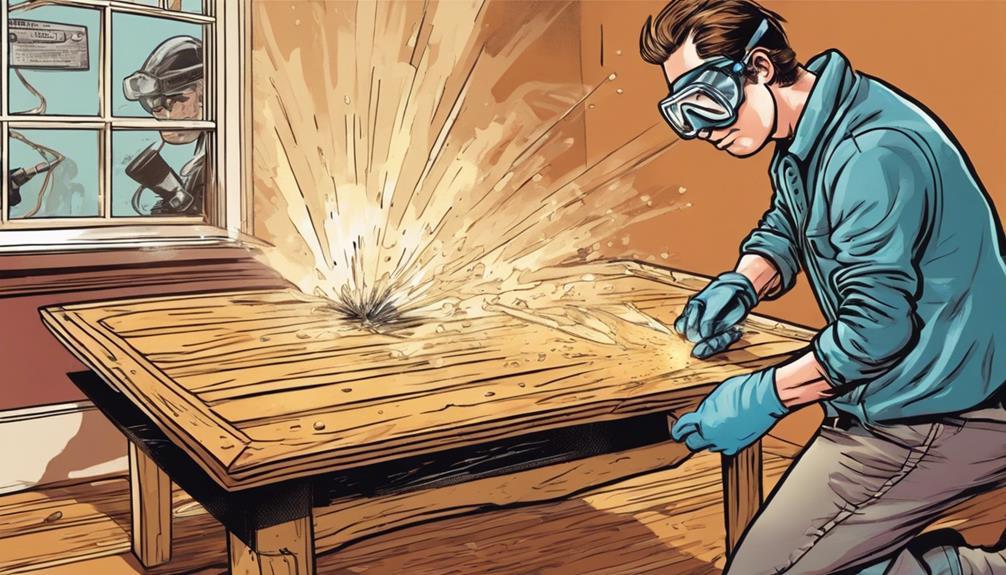
You can start by gently melting the shellac finish on your coffee table using methylated spirits for easy removal.
Break through the finish with a nylon abrasive pad, ensuring no damage to the wood.
Opt for fine wire wool to effectively remove the old finish without harsh chemicals or sandpaper.
Gentle Finish Removal
Wondering how to gently eliminate the finish from your coffee table without causing damage to the wood surface? Here are some effective techniques to help you achieve a refreshed look while preserving the integrity of the wood:
- Utilize methylated spirits: Use this solution to dissolve the shellac finish gently, avoiding the need for aggressive sanding.
- Employ a nylon abrasive pad: Break through the finish layer delicately to maintain the wood's original beauty during the restoration process.
- Choose fine wire wool: Opt for this gentle material to effectively eliminate the finish without resorting to harsh chemicals that may harm the wood.
- Dry off the wood thoroughly: After removing the finish, make sure the wood is completely dry before applying wax to protect the surface and enhance its color.
- Buff the waxed surface: Achieve efficient and beautiful results by buffing the waxed surface to a smooth finish, preserving the natural beauty of the wood within minutes.
Efficient Restoration Process
To efficiently restore your coffee table, consider utilizing gentle finish removal techniques that preserve the wood's integrity and original beauty.
For instance, on a mahogany coffee table from 1720 with a shellac finish, you can gently remove the finish using methylated spirits, wire wool, and a nylon abrasive pad. This approach avoids the need for harsh chemicals or sandpaper, safeguarding the wood from unnecessary damage.
After removing the finish, make sure to dry off the wood thoroughly before applying wax. This step not only enhances the wood's color but also helps in preserving its natural beauty.
This restoration process can work wonders in as little as 3 to 5 minutes, showcasing the efficiency and effectiveness of these wood restoration techniques.
Sympathetic Wood Treatment
Using fine wire wool and methylated spirits for gentle finish removal can effectively preserve the historical integrity of your mahogany coffee table during the sympathetic wood treatment process. This approach allows you to restore the table without causing damage or altering its original charm.
Here are some key points to take into account:
- Preservation of Historical Integrity: Gentle removal techniques help maintain the authenticity and character of the mahogany wood.
- Avoidance of Chemicals and Sandpaper: The use of wire wool eliminates the need for harsh chemicals or abrasive sanding, ensuring a safe and respectful restoration.
- Enhanced Color and Texture: Applying wax post-treatment enriches the wood's appearance, highlighting its natural beauty.
- Smooth Finish: Buffing the surface after waxing results in a polished look that showcases the coffee table's elegance.
- Efficient Restoration: Achieve a stunning transformation in minutes, revitalizing the table without the need for aggressive sanding methods.
Step-by-Step Wood Treatment Process
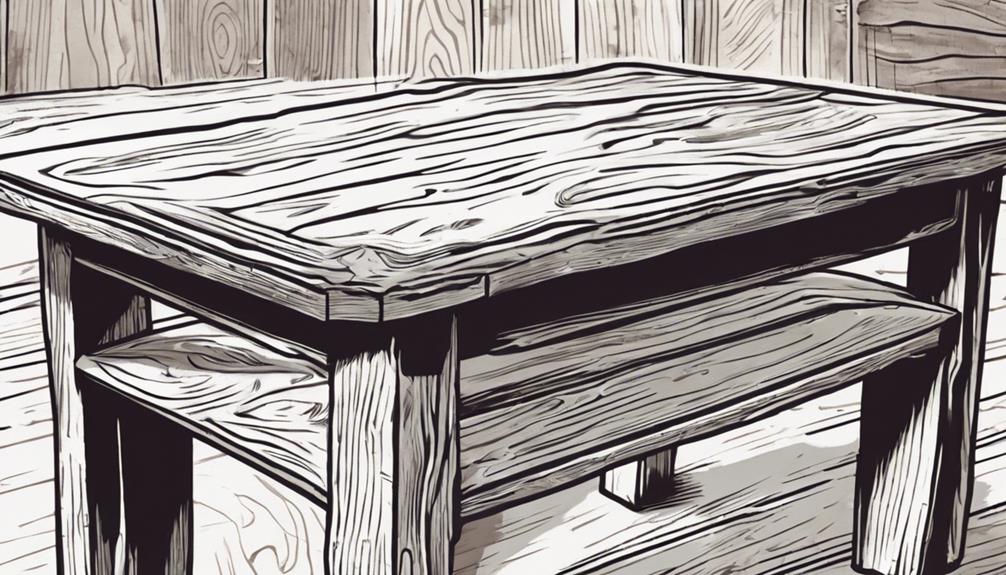
Start by gently removing the old shellac finish on the mahogany coffee table using methylated spirits, wire wool, and a nylon abrasive pad. This process helps strip away the old coating, preparing the wood for the next steps.
Once the finish is removed, make sure the wood is completely dry before applying a wax treatment. The wax not only enhances the wood's color but also provides a protective layer for the surface. Apply the wax evenly and then buff the surface to achieve a smooth and polished finish, showcasing the natural beauty of the mahogany.
This restoration method is quick, taking only 3 to 5 minutes, and eliminates the need for harsh chemicals or extensive sanding. By following these simple steps, you can efficiently rejuvenate your mahogany coffee table, bringing it back to life without causing any harm to the wood.
Efficient Transformation Methods
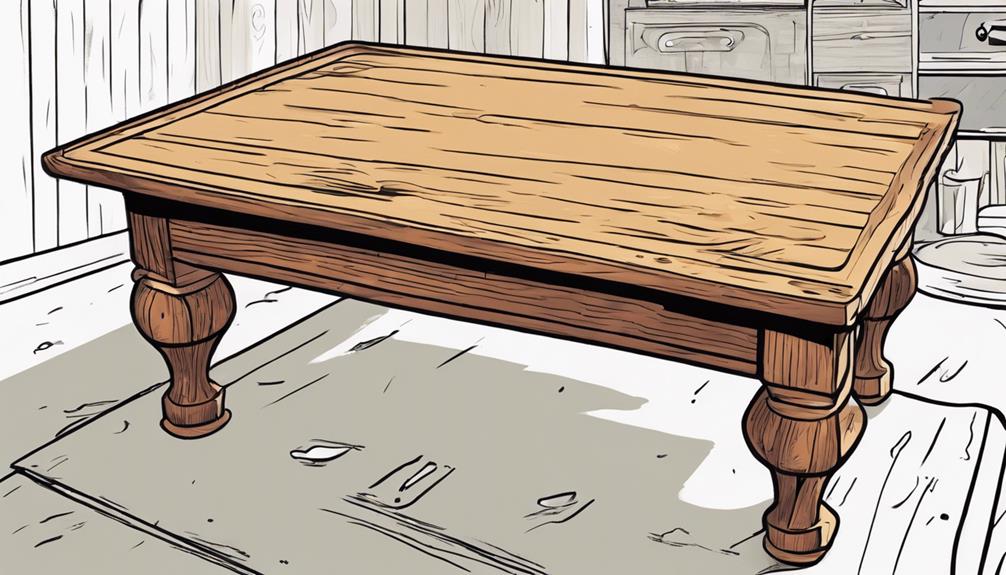
You can revitalize your coffee table efficiently by using quick restoration techniques and effective wood treatment methods.
Achieve a beautiful finish within minutes without resorting to harsh chemicals or sandpaper, preserving the wood's original beauty.
Enhance the color and texture of the wood by utilizing simple materials like wax, nylon abrasive pads, and fine wire wool.
Quick Restoration Techniques
Effortlessly revitalize your coffee table with efficient restoration methods that bring it back to life in just a matter of minutes. Consider gentle techniques such as removing the shellac finish with methylated spirits and wire wool, achieving a beautiful transformation without harsh chemicals or sanding in only 3 to 5 minutes.
Preserve the historical significance of your mahogany coffee table with a sympathetic restoration approach. Enhance its color and beauty by applying wax and buffing for a smooth finish. Experience rapid results by utilizing simple materials like nylon abrasive pads and wax.
Transforming your coffee table doesn't have to be a time-consuming task. By following these quick restoration techniques, you can revive your furniture efficiently and bring out its natural beauty. With just a few minutes of work, you'll see a remarkable difference in the appearance of your beloved coffee table.
Effective Wood Treatment
Optimize your coffee table's appearance through efficient wood treatment methods that swiftly rejuvenate its natural beauty. To start, gently remove the shellac finish using methylated spirits and wire wool. This technique allows you to strip away the old finish without damaging the wood underneath.
Explore the historical significance of mahogany wood, which was first imported from the Americas in 1720 and has since been a prized material for furniture making due to its durability and rich color.
For a quick and effective restoration process that avoids harsh chemicals and sanding, consider using nylon abrasive pads. These pads can help you restore the wood's natural luster without causing any unnecessary damage.
After removing the finish, apply wax to enhance the wood's color and texture while preserving its innate beauty. By following these steps, you can achieve a beautiful, undamaged result in just 3 to 5 minutes, all while taking a gentle and sympathetic approach to wood restoration.
Preservation of Wood's Natural Beauty
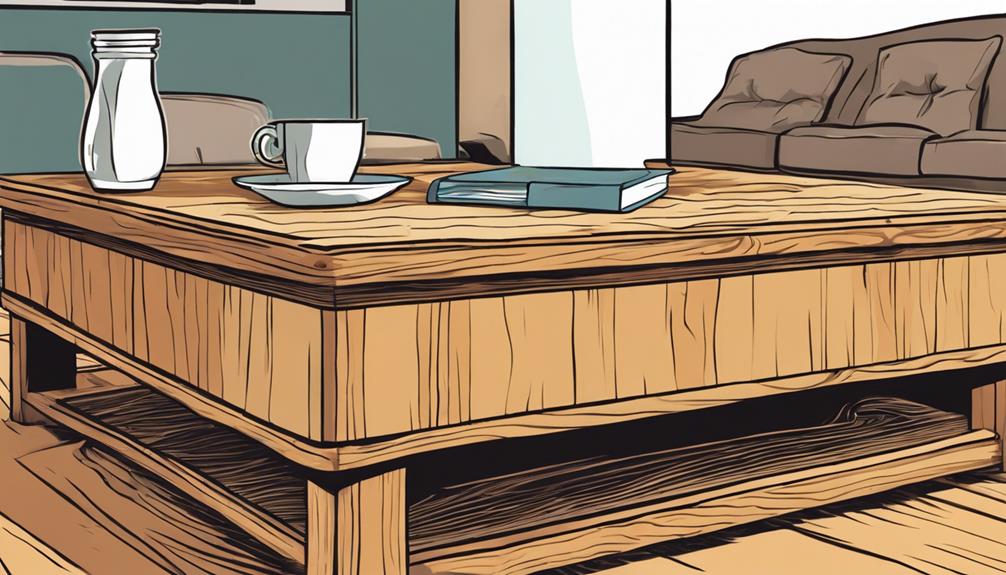
To maintain the natural beauty of wood, it's vital to handle it gently while eliminating old finishes with denatured alcohol and nylon abrasive pads. This process aids in revealing the wood's original allure while preparing it for restoration. Remember to handle wood with care to sustain its aesthetic appeal and quality over time. Here are some key points to emphasize:
- Delicate Cleaning: Use denatured alcohol and nylon abrasive pads for a thorough yet gentle removal of old finishes.
- Conservation: Preserve the wood's natural beauty by avoiding harsh chemicals that can diminish its shine.
- Improvement: Apply wax after cleaning to enhance the wood's color and safeguard it from future damage.
- Polishing: Achieve a smooth and refined finish by gently polishing the wood surface.
- Durability: By conserving the wood's natural beauty, you safeguard that your furniture piece remains a timeless and sophisticated addition to your space.
Rapid Restoration Without Sanding
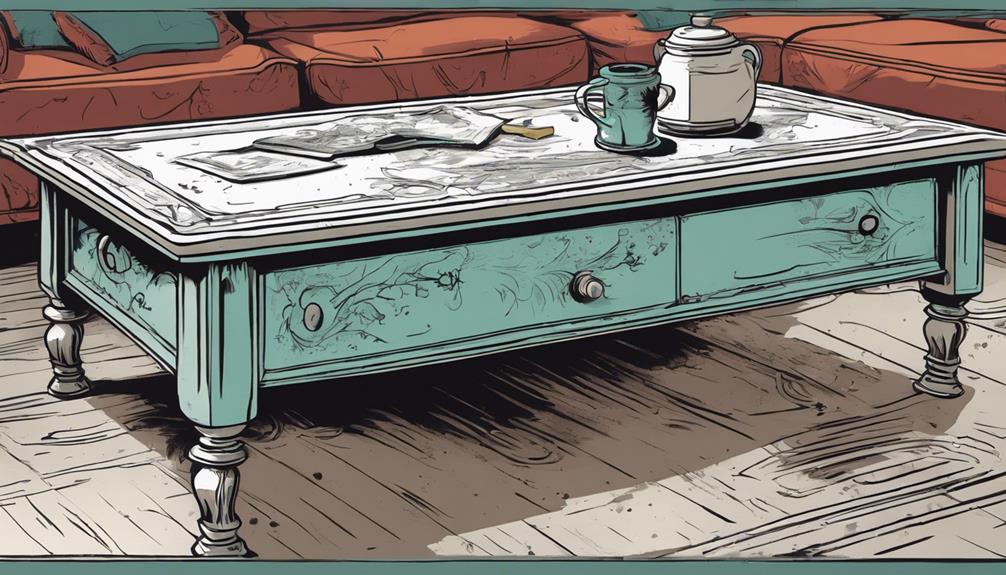
You can achieve a rapid restoration of your coffee table without the need for sanding.
By utilizing gentle techniques like melting shellac finish with methylated spirits and using wire wool and nylon abrasive pads, you can quickly revive the wood's surface.
Experience efficient and effective transformation within minutes, preserving the wood's integrity and bringing back its natural beauty.
Sanding-Free Restoration
Revive your coffee table effortlessly with a rapid restoration technique that skips the sanding process. By utilizing methylated spirits to dissolve the shellac finish, you can achieve a smooth restoration without the labor-intensive sanding step.
Here's how to achieve a sanding-free restoration:
- Use methylated spirits to dissolve the shellac finish.
- Gently eliminate the finish with a nylon abrasive pad and fine wire wool.
- Speed up the process within 3 to 5 minutes, avoiding harsh chemicals and sandpaper.
Apply wax to enhance the wood's color after drying off the wood post-finish removal. Achieve a sympathetic restoration with simple materials, preserving the wood's beauty effectively.
This method not only saves time and effort but also guarantees that your coffee table retains its natural charm without the risk of damage from aggressive sanding techniques.
Quick and Gentle Revival
Achieving a rapid restoration for your coffee table, without the need for sanding, can be efficiently done with a quick and gentle revival technique. By following a simple process that takes only 3 to 5 minutes, you can bring new life to your beloved furniture piece. Avoid the hassle of rough sanding by utilizing methylated spirits, wire wool, and a nylon abrasive pad to gently remove the finish. This sympathetic restoration approach helps preserve the integrity of the wood without resorting to harsh chemicals or sandpaper.
To enhance both the color and finish of your coffee table, consider applying wax and buffing the surface for a smooth and polished look. This method not only revives your table quickly but also guarantees a beautiful outcome. The table below summarizes the key steps for a quick and gentle revival of your coffee table:
| Step | Materials Needed | Time Required |
|---|---|---|
| Finish Removal | Methylated Spirits, Wire Wool | 3-5 minutes |
| Surface Buffing | Nylon Abrasive Pad, Wax | 3-5 minutes |
| Final Polishing | Cloth for Buffing | 1 minute |
Simple Materials for Quick Refresh
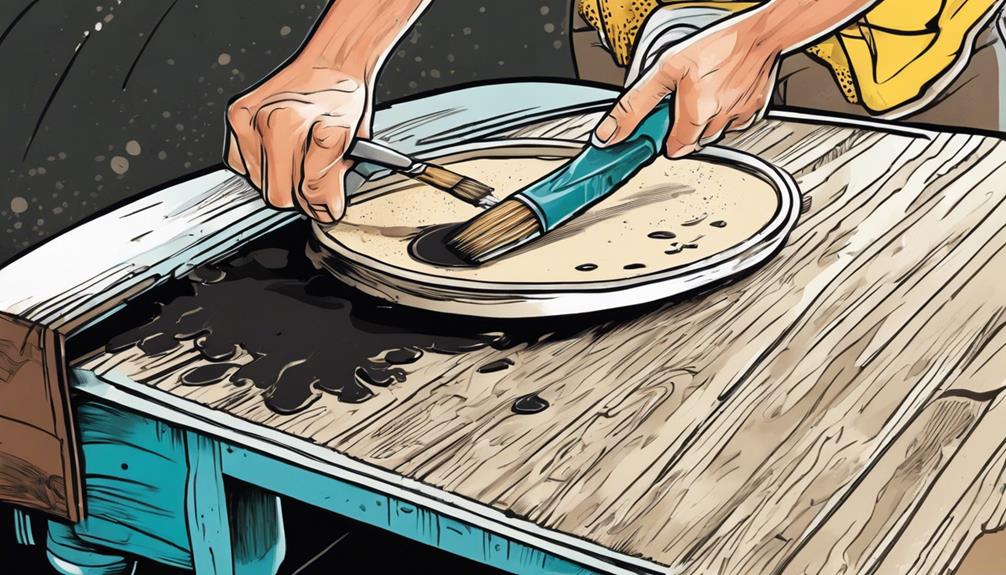
Looking to refresh your coffee table quickly and effectively? You can achieve stunning results with just a few simple materials. To bring your coffee table back to life, consider using methylated spirits, wire wool, and nylon abrasive pads. These materials provide a gentle yet effective way to remove the old finish without damaging the wood.
Here are five items to keep in mind:
- Methylated spirits: Ideal for cleaning and degreasing the surface before refinishing.
- Wire wool: Helps in gently removing the old finish without scratching the wood.
- Nylon abrasive pads: Useful for smoothing out any rough patches on the surface.
- Wax: Applying wax after the restoration process enhances the wood's color and creates a beautiful finish.
- Sympathetic restoration: By using these simple materials and techniques, you can achieve a stunning result while preserving the wood's integrity.
With these materials at hand, you can easily refresh your coffee table in just a few minutes, bringing back its natural beauty.
Achieving Beautiful, Undamaged Results
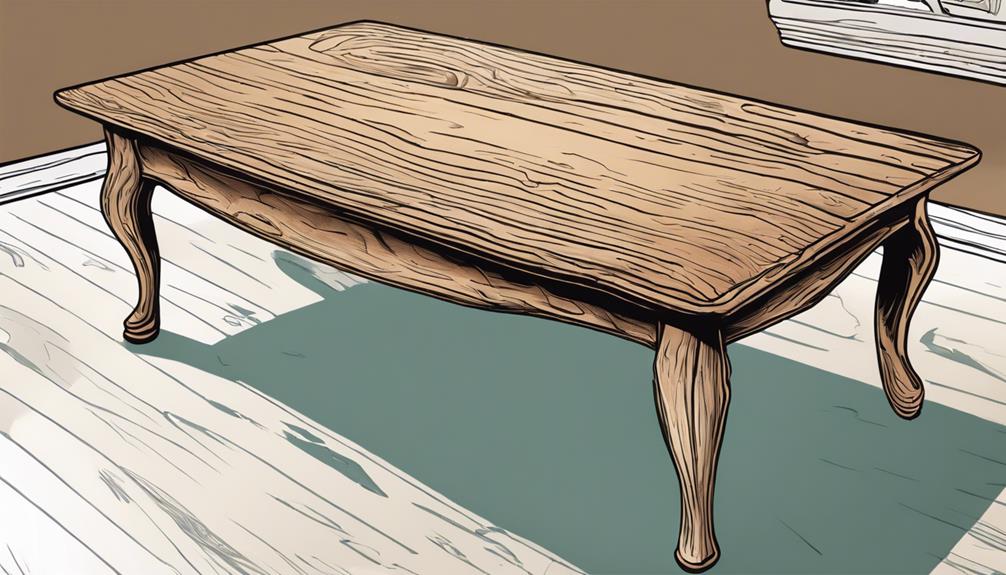
To achieve stunning, undamaged results in wood restoration, consider employing a gentle approach using methylated spirits and nylon abrasive pads. This method allows for the effective removal of old shellac finishes without the need for sanding, preserving the wood's integrity.
For antique mahogany furniture pieces dating back to the 1720s, a sympathetic restoration using fine wire wool and wax application can enhance the wood's natural beauty, showcasing its historical significance and desirability. By carefully removing the finish, ensuring the wood is adequately dried, and buffing it with wax, you can achieve a smooth and undamaged result.
This efficient wood restoration technique can breathe new life into a damaged coffee table within a short timeframe of 3 to 5 minutes, eliminating the necessity for harsh chemicals or rough sanding. Embrace this gentle approach to revitalize your coffee table, bringing out its inherent beauty while maintaining its structural integrity.
Enhancing Coffee Table's Elegance

Bring out the elegance of your coffee table by employing gentle restoration techniques that enhance its natural beauty and charm. Start by gently removing old finishes using methylated spirits, wire wool, and a nylon abrasive pad. This process helps preserve the wood's historical significance and beauty without resorting to harsh chemicals or sandpaper.
After removing the finish, apply wax to achieve a smooth and polished look, allowing the wood's natural color to shine through. Witness a rapid transformation of your coffee table in just 3 to 5 minutes, opting for efficient wood restoration techniques over rough sanding.
Enjoy the beautiful and undamaged result by utilizing simple materials and a gentle treatment process that brings your coffee table back to life. With just a little bit of sanding and a fresh coat of paint or varnish, your table can look brand new again. By taking the time to care for your furniture, you’ll be lifting your coffee table to its former glory and enjoying it for many more years to come. Additionally, ensuring that the legs and structure of the table are sturdy and secure will also contribute to its longevity. Reviving your coffee plant is a simple process that can be done with minimal effort, and the results will be well worth it. By taking the time to revive and refresh your coffee table, you’ll be able to enjoy it for years to come. Consider adding a stylish cushion to your revived coffee table to create a cozy and inviting space in your home. This simple addition can not only add comfort but also enhance the overall aesthetic of the table. By giving your coffee table a new lease on life, you’re not only saving money but also reducing waste and contributing to a more sustainable lifestyle.
- Gently remove old finishes: Use methylated spirits, wire wool, and a nylon abrasive pad.
- Preserve historical significance: Opt for a sympathetic restoration approach without harsh chemicals.
- Smooth and polished finish: Apply wax after finish removal for a natural color shine.
- Rapid transformation: Witness quick changes without rough sanding.
- Simple materials, beautiful results: Utilize gentle treatment for an undamaged outcome.
Frequently Asked Questions
How Do You Bring an Old Table Back to Life?
You bring an old table back to life by considering its wood type and history. Use gentle finish removal techniques like melting shellac and applying wax for color enhancement. Witness a rapid transformation without compromising its original charm.
How Do I Make My Table Look New Again?
You can make your table look new again by embracing a gentle restoration method. Remove the old finish with care, preserve its essence, enhance its beauty with wax, and enjoy a transformed piece without harsh chemicals.
How to Restore a Weathered Wood Table?
To restore a weathered wood table, gently remove the existing finish with methylated spirits and a nylon abrasive pad. Use wire wool for a smooth finish. Apply wax for protection and enhanced color. Enjoy the transformation in minutes!
How to Make a Dull Wood Table Shine?
To make a dull wood table shine, gently remove old finishes with methylated spirits, wire wool, and an abrasive pad. Apply wax for a radiant glow, then buff for a polished finish – revealing its natural beauty effortlessly.
Conclusion
Now that you've learned how to bring your coffee table back to life, remember that mahogany wood has been prized for centuries for its durability and beauty.
In fact, did you know that mahogany trees can grow up to 150 feet tall?
With the right techniques and a little elbow grease, you can transform your tired coffee table into a stunning piece that will be the centerpiece of your living room for years to come.
